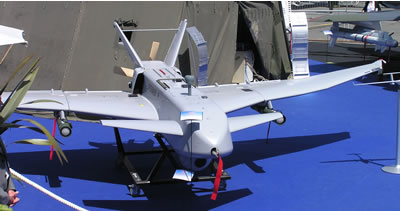Sperwer unmanned aerial system (UAS) is designed to support Intelligence, Surveillance, Target Acquisition and reconnaissance (ISTAR) at the battlegroup level (brigade to division).
The Sperwer system comprises three aerial vehicles, ground control station (GCS), transportable hydraulic catapult and ground data terminal (GDT) housed in the communications shelter carried on high mobility vehicles. The entire system can be transported in two C-130 aircraft and operate from unprepared sites using catapult launch, and parachute and airbags recovery.
The system supports simultaneous control of two aircraft, from a single GCS. Furthermore, several GCSs can control multiple missions, and can hand-over UAVs between each other. The ground station is provided with advanced mission planning tools, including 3D terrain modeling and flight path presentation on a geographical data system, image processing, interpretation and connection to C4I networks and compatibility with NATO datalinks and communications networks. To improve survivability and stealth, the GCS can be located up to 2 kilometers from the GDT.
The aerial vehicles are available in various models, including the basic design, long endurance (Sperwer B) and a Slow-Fast penetrator, a new tactical drone concept designed in cooperation with Dassault Aviation. Sperwer B currently under development, will use larger wings, which will store more fuel, doubling the aircraft endurance and payload capability. All air vehicles share common system architecture, advanced digital avionics suit, datalinks, ground stations and catapult. Sperwer is qualified to operate in harsh weather conditions, including temperature, wind, rain, icing etc. Sperwer B is also capable to operate at higher elevations of up to 18,000 feet.
Sperwer is designed to carry the Sagem OLOSP FLIR payload, providing high resolution day and night imagery and target geolocation with an accuracy of 20 meters. Other payloads designed for Sperwer include ELINT, COMINT, communications relay and SAR. The aircraft is equipped with a digital J band datalink (15GHz) and transponder/IFF (Mode 3C) and VHF relay for easy integration in controlled airspace. Sperwer B will be able to carry multiple payloads (EO/IR and SAR or EO/IR and relay etc.) It will also be equipped with two underwing hardpoints, to carry external loads of up to 30kg each. Sagem has already demonstrated the integration of Sperwer B with the SPIKE LR missile and is cooperating with GIAT, to test a new smart munition delivery system, based on the Bonus submunition. According to Sagem, the armed configuration requires the reduction of up to 20 kg of fuel, thus limiting the endurance of the armed Sperwer.
Sperwer Operators:
The system is currently in use with the Canadian, which deployed the system in Afghanistan. It is also used by the Swedish (dubbed UGGLAN), Dutch forces, and was recently acquired by the Greek Army. A derivative of the Sperwer – System de Drone Tactique Intermediare (SDTI) is also in operation with the French Army. It entered service in 2003 as a replacement for Sagem’s Crecerelle system. According to some reports, Pakistan and Saudi-Arabia are also interested in this system. The Sperwer was first deployed to Afghanistan in 2003 as part of the ISAF. Since March 2006 the UAV is back in Afghanistan for operations in the Kandahar region.
Canada Order More Sperwers
Canada procured SPERWER TUAVs in 2003 to meet requirements for Operation ATHENA, Canada’s contribution to the International Security Assistance Force (ISAF) in Afghanistan. In in Decembert 2005 Canada announced the procurement of five additional Sperwers at a cost of C$15 million covering attrition, maintaining system availability throughout the vehicle’s repair and turn-around time. The UAVs were delivered in early 2006 by Oerlikon-Contraves Canada, acting as Canadian prime contractor for France’s SAGEM. Following the deactivation of the Danish Army Sperwer unit, Canada acquired the Danish systems, which will reinforce its UAV fleet. The Danish systems will be standardized by Sagem to the Canadian configuration (ground station and aerial vehicles).

















